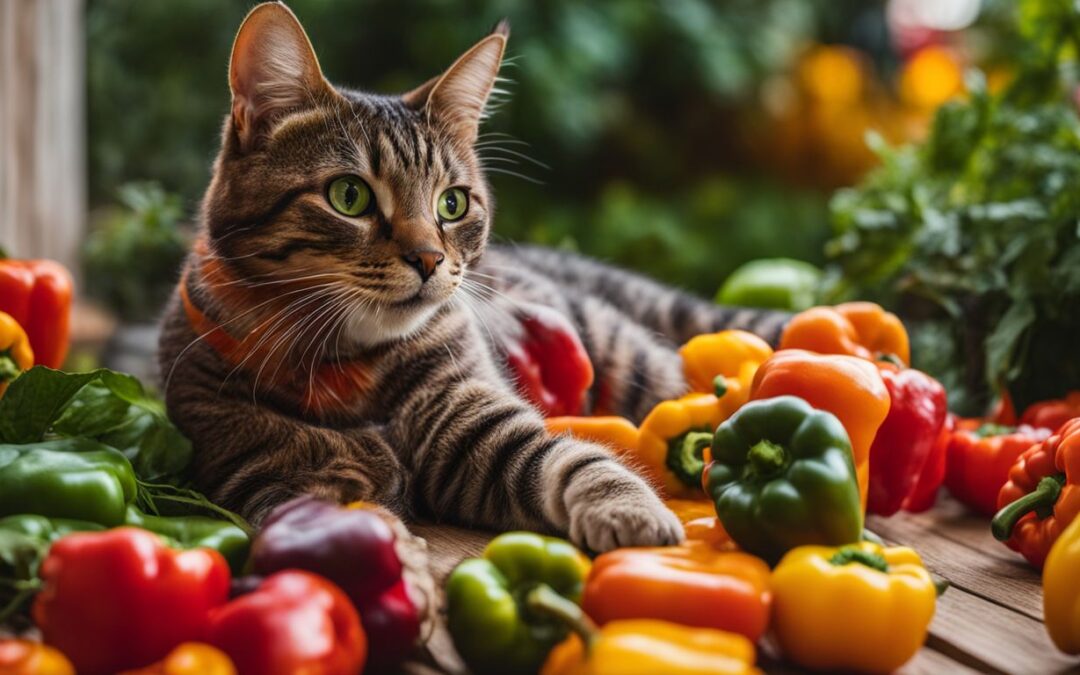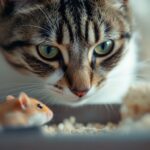Are you wondering if your feline friend can snack on peppers? It’s a common question among cat owners. This article will clear up the confusion around cats and bell peppers, highlighting both their safety and health benefits.
Discover how to safely incorporate this veggie into your cat’s diet. Keep reading to learn more!
Key Takeaways
- Cats can eat bell peppers without any toxicity, making them a safe snack when given in moderation.
- Bell peppers provide essential vitamins A, C, and K to cats, along with fiber and water content that aids in digestion and hydration.
- Always remove seeds and stems from bell peppers before feeding them to your cat to prevent choking hazards or digestive issues.
- Introduce bell peppers slowly into your cat’s diet in small amounts, watching for any signs of digestive upset or allergic reactions.
- Offering different colors of bell peppers can add variety to your cat’s meals while allowing you to discover their flavor preferences.
Are Bell Peppers Toxic to Cats?
Bell peppers are not toxic to cats, and they can safely eat them in moderation.
No, bell peppers are not toxic to cats
Cats can safely eat bell peppers without the risk of toxicity. These vegetables are not poisonous to felines and fit well into a balanced diet. While peppers don’t provide significant nutritional value for cats, they’re not harmful if your pet shows an interest in snacking on them.
Introducing bell peppers to a cat’s diet should always be done with caution. Make sure to remove any seeds and stems that could pose choking hazards or digestive issues. Feeding cats small, manageable pieces ensures they can explore this new food safely.
Offering bell peppers occasionally adds variety to their meals without introducing any risks associated with toxic plants or spicy foods.
Cats can safely eat bell peppers in moderation
Bell peppers are safe for cats to eat in moderation. These colorful vegetables contain vitamins A, C, and K, along with high fiber and water content. Feeding bell peppers can help improve digestion for your feline friend.
It’s essential to remove the seeds and stems before offering them to your cat and provide small amounts at a time to prevent any potential digestive issues.
To ensure your cat’s safety, limit their intake of bell peppers while enjoying the health benefits they provide. Cats can enjoy this vegetable as an occasional treat as part of a balanced diet.
Health Benefits of Bell Peppers for Cats
Bell peppers are packed with vitamins A, C, and K – essential for your cat’s overall health. Their high fiber and water content can aid in digestion and hydration for your feline friend.
Contains vitamins A, C, and K
Bell peppers are a good source of vitamins A, C, and K for cats. These essential nutrients support your cat’s overall health and well-being. Vitamin A promotes healthy vision, vitamin C boosts the immune system, and vitamin K aids in blood clotting.
Providing bell peppers as part of a balanced diet can help ensure that your cat receives these important vitamins.
In addition to being a source of crucial vitamins for cats, bell peppers also offer high fiber content which aids in digestion and helps maintain proper bowel movements. The water content in bell peppers can also contribute to keeping your cat hydrated.
High in fiber and water content
Bell peppers are high in fiber, aiding in digestion for your feline friend. The water content helps keep your cat hydrated and supports overall urinary tract health.
Helps improve digestion
Bell peppers are high in fiber and water content, aiding in digestion for cats. The combination of these two elements helps regulate bowel movements and maintain a healthy digestive system.
Additionally, the vitamins found in bell peppers support overall gastrointestinal health, making them a valuable addition to a cat’s diet.
Furthermore, the fiber content in bell peppers promotes good bacteria growth in the gut, which contributes to better digestion and nutrient absorption. This supports the overall well-being of your feline friend and ensures they receive maximum nutritional benefits from their food.
How to Safely Feed Your Cat Bell Peppers
When feeding your cat bell peppers, remember to remove the seeds and stems before offering them in small amounts. Ensure you offer variations in color and flavor to keep your cat interested in this healthy treat.
Remove seeds and stems
Remove seeds and stems from bell peppers before feeding them to your cat. This helps prevent any potential choking hazards or digestive issues that may arise from these parts of the pepper.
By taking this simple step, you can ensure that your cat can safely enjoy the benefits of this nutritious vegetable without any risks associated with consuming the seeds or stems.
Keep in mind that removing seeds and stems is crucial when offering bell peppers to your feline friend, as it allows for a safer and more enjoyable eating experience.
Feed in small amounts
Feed bell peppers to your cat in small amounts, ensuring that it is a rare treat rather than a regular part of their diet. Introduce small pieces gradually and monitor for any signs of digestive upset or allergic reactions.
Moderation is key when offering new foods like bell peppers to your furry friend, so limit the portion size to avoid any discomfort.
When sharing this tasty snack with your cat, keep an eye on how they respond and consult with your veterinarian if you have any concerns about incorporating bell peppers into their diet.
Variations in color and flavor
Bell peppers come in a variety of vibrant colors, including green, red, yellow, and orange. Each color offers a unique flavor profile, with green bell peppers having a slightly bitter taste compared to the sweeter notes found in the ripe red, yellow, and orange varieties.
These different flavors can add variety to your cat’s diet if they enjoy the taste of these colorful vegetables.
When it comes to feeding bell peppers to your cat, make sure to introduce small amounts at first to gauge their preference for flavor and tolerance. Cats may have individual preferences when it comes to the color and flavor of bell peppers; some might prefer one color over another due to its specific taste profile.
Offer small portions of each color variant and observe which one your feline friend prefers.
Conclusion
Cats can safely enjoy bell peppers, which offer vitamins A, C, and K as well as fiber and hydration. To feed your feline these veggies, remove seeds and stems, offering small portions.
This adds diversity to their diet and contributes to overall health.
FAQs
1. Can cats eat peppers safely?
Yes, cats can have bell peppers in small amounts as they are not toxic to them, but it’s important to avoid spicy peppers and onions because they can be harmful.
2. Are there any vegetables that are safe for cats to eat besides bell peppers?
Cats can eat certain vegetables safely; however, always check which ones are safe since some like onions are poisonous plants for felines.
3. What happens if my cat eats a hot pepper or something spicy?
If your cat eats something spicy like hot peppers, it might experience discomfort or digestive issues because spicy food is not suitable for their diet.
4. Can giving bell pepper plants to my cat cause any risks?
While the bell pepper itself isn’t harmful, eating large parts of the plant could upset your cat’s stomach. It’s best to stick to small pieces of the vegetable itself.
5. How should I introduce vegetables like bell peppers into my cat’s diet?
Introduce any new food, including safe vegetables like bell peppers, slowly and in tiny amounts to see how your cat reacts before making it a regular part of their diet.






